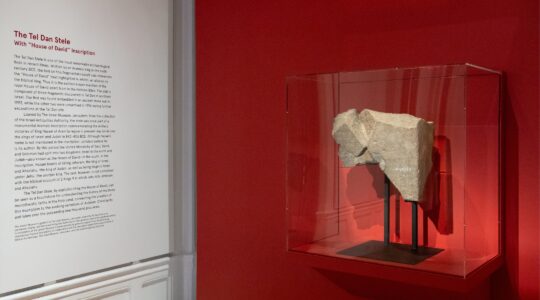Fifty years ago, Harry Golden published “Enjoy, Enjoy,” his landmark collection of work from more than 20 years as the editor of the self-founded, self-published and self-written newspaper The Carolina Israelite. During his 1941-’68 tenure, Golden reminisced about his childhood on Rivington Street, pondered ancient history and argued for integration.
The paper appeared about every two months, and had 30,000 subscribers at its peak. Adlai Stevenson, William Faulkner and Earl Warren subscribed. So did both of my grandfathers — one in Great Neck and the other in Petersburg, Va. Unlike Northern newspapers, The Carolina Israelite was not directed only toward Jewish readers. Instead, Golden used his Jewishness to tell about the South.
With a revival of Alfred Uhry’s Pultizer Prize-winning play “Driving Miss Daisy,” about the unlikely friendship between an elderly Jewish widow in Atlanta and her black chauffeur, opening on Broadway next week, the experiences of blacks and Jews in the South will be on full view. So it is especially timely to look back on Golden’s singular approach to black-Jewish relations, especially during the civil rights era, and his take on the complicated identity politics of that time. Golden might not have lived long enough to see a day when an African-American could become president of the United States, but his insistence on straddling the line between fitting in and standing out strikes a very modern chord in the wider discussion of Jews’ place in America.
By all accounts, Harry Golden was a character — a short, stout man always chomping on a cigar, spinning tales of a Lower East Side upbringing to a Charlotte, N.C., audience. He wound up in Charlotte through newspapers, though he was not originally a journalist. In 1929, living in New York (his family had emigrated from a Ukrainian shtetl) and using his original name of Herschel Goldhurst, Golden was arrested for taking part in a stock brokerage “bucket shop” — a firm that takes retail orders without following through — and spent four years in jail. He changed his name, and arrived in the South to sell advertisements for a newspaper in Norfolk, Va. He eventually took a similar job in Charlotte, and settled down there.
Golden started The Carolina Israelite in 1941, and used its pages to discuss anything he found interesting, which increasingly came to be civil rights.
In his paper, Golden set out “Golden Plans” designed to integrate the Jim Crow South. Give black women white babies to carry so they can gain admission to movie theaters, Golden wrote. Take away diner stools so everyone, black and white, has to stand (he called this plan Vertical Integration). Put out-of-order signs on whites-only drinking fountains so people have to share.
To eliminate anti-Semitism, Jews should convert en masse. Either that, or give every anti-Semite enough Jewish food (Golden suggested bagels with lox, or chicken liver with radish) to convince him that Jewish people were actually all right. With gentle, accessible satire, he railed against the prevailing order.
Reviewers generally adored his lighthearted way of looking at grave topics. “It is more fun to read Mr. Golden than to talk about him,” wrote his fan R. L. Duffus in 1962 in The New York Times. “Underneath, he is good for all of us.” The Calvin Trillin-devised Harry Golden Rule states that it’s hard to invent something so outlandish that it might not actually happen.
Golden’s Israelite writings were collected and published in books including “Enjoy, Enjoy” (1960), Only in America (1958) and For 2 Cents Plain (1959). He wrote other books as well — a biography of his friend Carl Sandburg, a history of the Leo Frank case, a treatment of John F. Kennedy’s relationship with African-Americans, and other personal writings in, for example, “You’re Entitle” (1962) and “Ess, Ess, Mein Kindt” (1966).
In his writings, Golden braided Southerners and Jews together, as he did his own Jewish raising and his life in North Carolina. “I think that Southern writers have gone overboard in their debunking of the ‘moonlight and magnolias’ of the South,” he wrote in an Israelite entry. “This great culture which was based on family, tradition, and history was never really a myth. It had its parallel among the early Jewish immigrants to America. I saw many elderly Jews sitting in damp stores picking rags. It was no myth to them that they were of the chosen people. Thus when we speak of the old ‘Southern aristocracy’ we are joking and at the same time we are not joking.”
With this, Golden discounted the idea that a factual past can matter as much as a heritage of the mind. Feeling “chosen” or “aristocratic” is enough to motivate a community, he seems to say with his collision of the old South and the old Lower East Side.
n
Support the New York Jewish Week
Our nonprofit newsroom depends on readers like you. Make a donation now to support independent Jewish journalism in New York.
Yet how could a civil rights activist, who came face to face with the inheritance of a slave system every day, romanticize the “moonlight and magnolias” South? Perhaps in the same way he liked to cling to his vision of the turn-of-the-century Lower East Side, a teeming, rough-around-the-edges place, as one where children played happily and drank drugstore soda water “for 2 cents plain.”
Some Jewish readers saw the ellipses in his halcyon New York reminiscences, and found his writings facile. In Commentary magazine in 1961, Editor Theodore Solotaroff quipped that Golden’s next book should be titled “Enough Already.”
“[Golden] is much more interested in explaining the Jews to the Gentiles than he is in portraying the special comedy and pathos of the ghetto for their own sake,” Solotaroff wrote, criticizing Golden for failing to delve deep enough to disturb the “desperately held notions that our society is fundamentally fine.”
Yet Golden’s appeal included his ability to have it both ways — as he wrote, “and at the same time we are not joking.” Someone jibed that after death, Golden would wind up in his own heaven, which would of course resemble the New York neighborhood of his youth. Golden responded that “anyone else who thinks I can go only to the Lower East Side ought to be reminded that I have written more about the South than I have about any other place. Or state of mind.” By claiming his South and labeling it a “state of mind,” Golden permitted himself to wander in and out of it, sometimes taking the role of a savvy insider and sometimes that of a wide-eyed observer.
For all his dreamy history, Golden showed that he did understand the vexed identity politics he wrote about, his own included. He used to joke to local Charlotte audiences that he was one of them because he had paid for a local burial plot. At the same time, he knew that to many North Carolinians, “I am not only a Jew, but a Yankee Jew at that.”
Golden used that role to examine race relations without taking the part of the whites, understanding that as a Jew, he could not simply glide into the majority culture of the South. Golden claimed that Jews and African-Americans shared a friendly history in the South because Southern Jewish store-owners allowed black customers to try on clothes and addressed them as “Mr.” when others did not. “The white Protestant in the South loves ‘the Jewish people,’ but is highly suspicious of the individual Jew. His emotions are in reverse with respect to the Negro. He loves the individual Negro, but hates the ‘people,’” Golden wrote.
Golden’s outsider-insider position gave him a unique vantage point to discuss Southern Jewishness, and he observed the keen longing for assimilation that plagued some Southern Jews. “Nothing reflects this desire more poignantly than the all too common boast that ‘My son looks like a Georgia cracker (or a ‘Tarheel’ or a ‘Tennessee mountaineer’).” For a contemporary example of this phenomenon, see Edward Cohen’s insistence upon his blond and “Gentile” looks as a child in his 2005 memoir “The Peddler’s Grandson.”
The title of Golden’s 1974 book, “Our Southern Landsman,” exemplifies his understanding of his own identity. With the word “our,” Golden disincludes himself from the Southerners; he is speaking to a group of which he is a part. The book is a sort of let-me-explain-it-to-you field guide, written for Jewish readers who shared his Northern background. In it, Golden writes about such famous Southern Jews as Judah P. Benjamin and Judah Touro, as well as “Confederate ladies” like Charleston poet Penina Moise. He includes such luminaries as Isaac Harby, who helped to found the Jewish Reform movement in the early 19th century, the three Jewish renegades who rode with John Brown, and Sam Massell, the first Jewish mayor of Atlanta. In his usual line-straddling fashion, he managed to heighten awareness of Southern Jewish history, but at the same time maintain an anthropological distance.
At the time of “Enjoy, Enjoy’s” publication in 1960, Golden was at the height of his unique ability to combine humor and social criticism. As time wore on, however, Golden grew less likely to laugh at the civil rights crisis in the South. He coined no more Golden plans, and in 1967, he resigned from the Student Nonviolent Coordinating Committee (SNCC) after he read a cartoon in SNCC’s monthly bulletin that he believed was pro-Arab and pro-Communist. The next year he ended the Carolina Israelite. “The fight for civil rights lost its romance,” he said. “There is nothing funny about it anymore.”
Golden died in Charlotte in 1981, and a memorial to him stands on the central campus of Central Piedmont Community College in Charlotte. Even a half-century after his first collection came out, his ability to envision and analyze the layers of Southern identity remains his legacy as much as his daring to speak out against the injustice he saw in his adopted country.
“When you are worried about others,” Golden wrote, “you are fearless. When you fight for others, you build an impregnable wall of security around yourself.”
Eliza McGraw is the author of “Two Covenants: Representations of Southern Jewishness” (LSU Press).
Support the New York Jewish Week
Our nonprofit newsroom depends on readers like you. Make a donation now to support independent Jewish journalism in New York.
The New York Jewish Week brings you the stories behind the headlines, keeping you connected to Jewish life in New York. Help sustain the reporting you trust by donating today.




